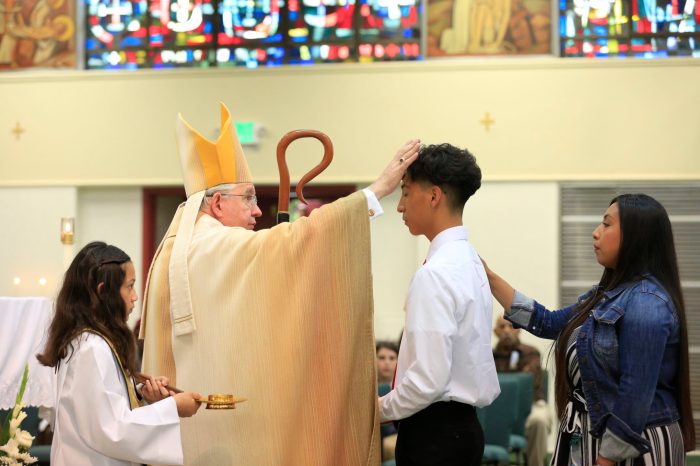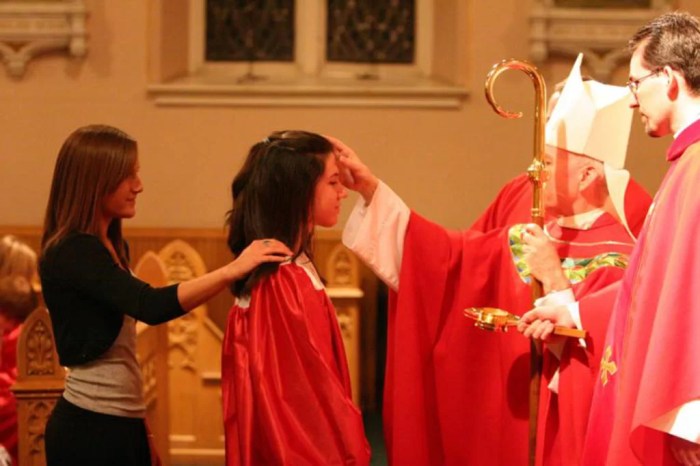The Roman Catholic Rite of Confirmation is a sacrament that plays a pivotal role in the Catholic faith. It strengthens the recipient’s relationship with God and the Church, empowering them to witness their faith boldly. This comprehensive guide delves into the historical, scriptural, theological, liturgical, and pastoral aspects of the sacrament, providing a thorough understanding of its significance and implications.
Throughout history, the Rite of Confirmation has evolved, reflecting the changing needs and understanding of the Church. Its biblical foundations lie in the New Testament, where it is seen as a continuation of the apostles’ mission of spreading the Gospel.
Theologically, Confirmation strengthens the recipient’s faith, deepening their relationship with the Holy Spirit and the community of believers.
Historical Context
The Roman Catholic Rite of Confirmation has its origins in the early Church, with roots in both the Jewish and Christian traditions. The sacrament of Confirmation is believed to have developed from the practice of the laying on of hands, which was used in the Old Testament to confer the Holy Spirit and to commission individuals for special tasks.
In the New Testament, the laying on of hands is mentioned in several passages, including Acts 8:14-17, where the apostles Peter and John lay hands on the Samaritan converts, and Acts 19:1-7, where Paul lays hands on the disciples in Ephesus.
These passages suggest that the laying on of hands was used in the early Church to confer the Holy Spirit and to confirm the faith of new converts.
The Development of Confirmation
Over time, the practice of the laying on of hands evolved into the sacrament of Confirmation. The first clear evidence of Confirmation as a distinct sacrament comes from the writings of Tertullian in the late 2nd century. Tertullian referred to Confirmation as the “seal of the Lord” and described it as a separate rite from Baptism.
In the 4th century, the Council of Elvira (306) decreed that Confirmation should be administered by bishops only. This decree was later confirmed by the Council of Trent (1545-1563), which defined Confirmation as a sacrament that “confirms” Baptism and “imprints a character on the soul.”
Scriptural Basis
The Roman Catholic Rite of Confirmation finds its foundation in the biblical accounts of the New Testament. The sacrament is rooted in the teachings of Jesus Christ and the actions of the apostles.
Several key passages in the New Testament provide the scriptural basis for Confirmation:
Acts of the Apostles
- Acts 1:8:“But you will receive power when the Holy Spirit has come upon you; and you will be my witnesses in Jerusalem and in all Judea and Samaria and to the ends of the earth.”
- Acts 2:1-4:“When the day of Pentecost had come, they were all together in one place. And suddenly a sound came from heaven like the rush of a mighty wind, and it filled the entire house where they were sitting. And divided tongues as of fire appeared to them and rested on each one of them.
And they were all filled with the Holy Spirit and began to speak in other tongues, as the Spirit gave them utterance.”
- Acts 8:14-17:“Now when the apostles at Jerusalem heard that Samaria had received the word of God, they sent to them Peter and John, who came down and prayed for them that they might receive the Holy Spirit, for as yet the Spirit had not fallen upon any of them, but they had only been baptized in the name of the Lord Jesus.
Then they laid their hands on them and they received the Holy Spirit.”
These passages describe the descent of the Holy Spirit upon the apostles and the subsequent empowering of the disciples with spiritual gifts. The laying on of hands by the apostles is seen as a sign of the transmission of the Holy Spirit, which is the essential element of the sacrament of Confirmation.
Theological Significance
The Roman Catholic Rite of Confirmation is a sacrament that strengthens the baptized Catholic’s faith and deepens their relationship with God and the Church. It is the completion of the baptismal process and bestows upon the recipient the fullness of the Holy Spirit’s gifts.
Through Confirmation, the recipient receives an increase in the Holy Spirit’s gifts of wisdom, understanding, counsel, fortitude, knowledge, piety, and fear of the Lord. These gifts empower the confirmed Catholic to live out their baptismal vocation as witnesses to Christ in the world.
Relationship with God, Roman catholic rite of confirmation
Confirmation strengthens the recipient’s personal relationship with God. Through the outpouring of the Holy Spirit, the recipient experiences a deeper sense of God’s presence and love in their lives. This strengthens their faith and trust in God and enables them to grow in their spiritual journey.
Membership in the Church
Confirmation also signifies the recipient’s full membership in the Catholic Church. By receiving this sacrament, they are publicly acknowledging their commitment to Christ and the Church and are empowered to actively participate in the Church’s mission of evangelization and service.
Liturgical Celebration

The Rite of Confirmation in the Roman Catholic Church is a liturgical celebration that involves various elements and rituals. These elements and rituals are deeply rooted in the Church’s tradition and have significant theological and spiritual meaning.
The liturgical celebration of Confirmation typically takes place during a Mass, presided over by a bishop. The bishop is the ordinary minister of Confirmation, as he is the successor to the apostles and the one who has the fullness of the sacrament of Holy Orders.
Roles of Participants
The bishop, candidates, and sponsors each play specific roles in the liturgical celebration of Confirmation. The bishop, as the ordinary minister, presides over the celebration and invokes the Holy Spirit upon the candidates.
The candidates are those who are being confirmed. They have undergone a period of preparation and instruction, and they are ready to receive the sacrament of Confirmation.
The sponsors are adult Catholics who are chosen by the candidates to be their witnesses and guides in the faith. They assist the candidates in their preparation for Confirmation and provide support and guidance throughout their Christian journey.
Symbolism and Meaning
The Roman Catholic Rite of Confirmation is rich in symbolism and meaning, reflecting the significance of this sacrament in the Christian journey. Various elements within the rite carry profound theological and spiritual implications.
Anointing with Chrism
The anointing with chrism is a central act in Confirmation. Chrism, a consecrated oil, symbolizes the outpouring of the Holy Spirit and its transformative power. Through anointing, the candidate is marked as a member of the Christian community and receives the gifts of the Spirit, including wisdom, understanding, counsel, fortitude, knowledge, piety, and fear of the Lord.
Laying on of Hands
The laying on of hands by the bishop is another significant gesture in Confirmation. It signifies the transmission of the Holy Spirit and the apostolic succession of the Church. The bishop, as a successor to the apostles, invokes the Spirit upon the candidate, confirming their baptism and strengthening their faith.
Sign of Peace
The exchange of the sign of peace, known as the pax, is a symbolic act that follows Confirmation. It represents the reconciliation and unity that is brought about by the Holy Spirit. The peace shared among the newly confirmed and the assembled community signifies the bond of love and support that exists within the Church.
Preparation and Reception
Before receiving the sacrament of Confirmation, candidates undergo a period of preparation to ensure they are adequately instructed and spiritually ready.
The preparation process typically includes:
- Instruction in the Catholic faith, including the history, teachings, and practices of the Church.
- Examination of conscience and repentance for sins.
- Prayer and meditation to deepen one’s relationship with God.
Requirements and Expectations
To be eligible for Confirmation, candidates must:
- Be baptized Catholics.
- Have reached the age of reason (typically around 7 years old).
- Have a basic understanding of the Catholic faith.
- Be committed to living a Christian life.
Candidates are also expected to have a sponsor who is a confirmed Catholic and who will provide guidance and support throughout the preparation process and beyond.
Effects and Implications

Receiving the Roman Catholic Rite of Confirmation has profound effects and implications for the recipient, as it strengthens their baptismal commitment and enhances their role within the Church.
Through Confirmation, the recipient receives the gifts of the Holy Spirit, empowering them to become active witnesses of their faith. This includes the ability to speak out boldly about their beliefs, to live their faith in their daily lives, and to defend their faith against challenges.
Enhanced Role in the Church
Confirmation deepens the recipient’s membership in the Church and expands their responsibilities within the community.
- They are now fully initiated members of the Church, sharing in its mission and responsibilities.
- They are called to participate actively in the Church’s liturgy, catechesis, and works of charity.
- They have a special responsibility to witness to their faith in their communities and to support the Church’s mission.
Christian Witness
Confirmation empowers the recipient to be a more effective witness to their faith.
- They are given the courage and strength to share their faith with others, both in words and actions.
- They are equipped with the knowledge and understanding necessary to defend their faith against challenges.
- Their witness is a powerful force for evangelization, helping to bring others to the faith.
Comparative Perspectives

The Roman Catholic Rite of Confirmation finds its parallels in similar practices within other Christian traditions. While sharing fundamental beliefs in the Holy Spirit and its role in strengthening the faithful, these traditions exhibit unique interpretations and practices that reflect their respective theological and historical contexts.
Eastern Orthodox and Oriental Orthodox Traditions
In the Eastern Orthodox and Oriental Orthodox Churches, the sacrament analogous to Confirmation is known as Chrismation. It is typically administered immediately after Baptism and is considered an integral part of the initiation process. Chrismation involves anointing the recipient with consecrated oil, or myron, on various parts of the body, accompanied by prayers invoking the Holy Spirit.
Similar to Catholic Confirmation, Chrismation is believed to seal the recipient with the gifts of the Holy Spirit and strengthen them in their Christian faith.
Protestant Traditions
Protestant denominations have varying practices regarding the recognition of Confirmation. Some, such as Lutherans and Anglicans, maintain a rite of Confirmation or Affirmation of Baptism, which is typically administered during adolescence or early adulthood. This practice is seen as a confirmation of the baptismal vows made on behalf of the recipient as an infant.
In other Protestant traditions, such as Baptists and Methodists, Confirmation is not formally recognized, and the emphasis is placed on personal conversion and the believer’s direct experience of the Holy Spirit.
Similarities and Differences
Across these Christian traditions, there are shared beliefs in the importance of the Holy Spirit in the life of the faithful and the need for a rite of initiation that strengthens and confirms their faith. However, there are also significant differences in the timing, administration, and significance of these practices.
The Catholic Rite of Confirmation, with its emphasis on the bishop as the minister and the anointing with chrism, reflects a particular understanding of the role of the ordained ministry and the sacramental nature of the rite.
Pastoral Implications

The Rite of Confirmation, a significant sacrament in the Roman Catholic Church, offers profound pastoral implications for the life of the Church and the faithful. Its effective celebration and integration into the community’s life can foster spiritual growth, strengthen the bonds of unity, and enhance the Church’s mission.
To ensure the meaningful celebration of Confirmation, it is crucial to engage in thorough preparation. This involves providing catechetical instruction to candidates, fostering a sense of community and belonging, and creating a welcoming and supportive environment. By doing so, individuals can develop a deep understanding of the sacrament, its significance, and their role within the Church.
Nurturing Spiritual Growth
Confirmation empowers individuals to live out their baptismal calling more fully. Through the reception of the Holy Spirit, they receive gifts and graces that strengthen their faith and enable them to witness to Christ in the world. The sacrament fosters a deeper connection with God, leading to spiritual maturity and a commitment to ongoing formation.
Strengthening the Bonds of Unity
Confirmation reinforces the unity of the Church by bringing together individuals from diverse backgrounds and experiences. As candidates gather for preparation and celebration, they form bonds of fellowship and support. This sense of unity extends beyond the sacrament, fostering a spirit of collaboration and mutual care within the community.
Enhancing the Church’s Mission
Confirmed individuals are called to be active participants in the Church’s mission. They are equipped with the gifts of the Holy Spirit to witness to Christ, serve others, and build up the Kingdom of God. Through their involvement in ministries, outreach programs, and other forms of service, they contribute to the Church’s mission of spreading the Gospel and bringing about a more just and compassionate world.
Contemporary Challenges and Opportunities
The Roman Catholic Rite of Confirmation faces various contemporary challenges and opportunities that shape its relevance and impact in today’s world.
One challenge lies in the changing religious landscape, where secularization and individualism have led to a decline in traditional religious practices. The Church must find innovative ways to engage with youth and young adults, making Confirmation meaningful and relevant to their lives.
Opportunities for Growth
- Emphasis on Youth Empowerment:By empowering young people to take ownership of their faith and actively participate in the Church, Confirmation can become a transformative experience that fosters a sense of belonging and responsibility.
- Collaboration with Schools and Youth Groups:Partnering with schools and youth groups can provide opportunities for Confirmation preparation that is integrated into young people’s daily lives, making it more accessible and engaging.
- Digital Evangelization:Utilizing digital platforms and social media can reach youth who may not be actively involved in traditional parish settings, offering alternative avenues for faith formation and preparation for Confirmation.
FAQ Resource: Roman Catholic Rite Of Confirmation
What is the purpose of Confirmation?
Confirmation strengthens the recipient’s faith, deepens their relationship with the Holy Spirit, and empowers them to witness their faith boldly.
Who can receive Confirmation?
Catholics who have been baptized and have reached the age of discretion.
What are the requirements for Confirmation?
Candidates must be properly instructed in the faith, have a sincere desire to receive the sacrament, and be supported by a sponsor.